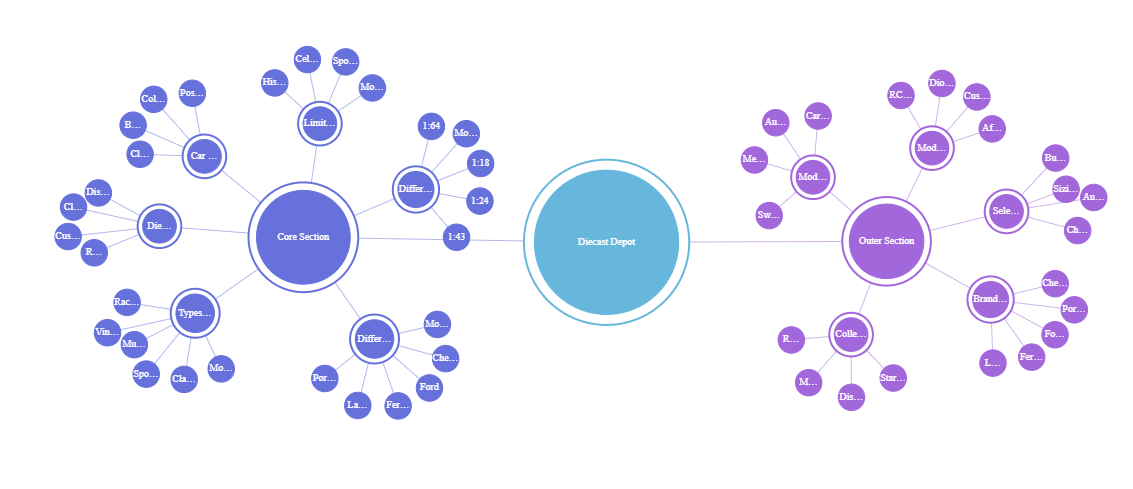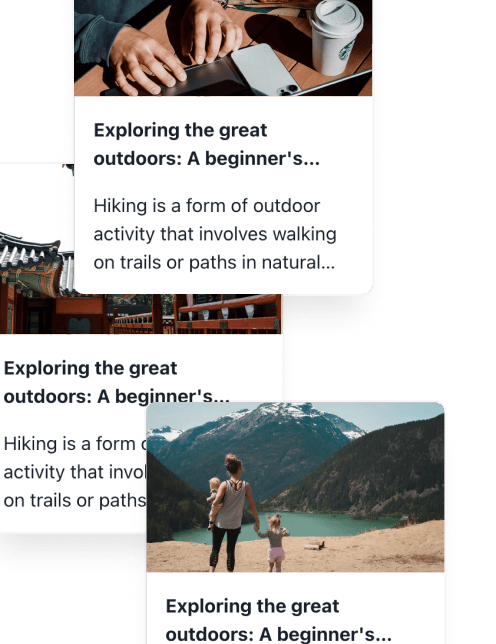A Detailed Guide on How to Create a Topical Content Map

Imagine your website as a library where readers cannot find the right shelf: content exists but search engines do not see the theme. A topical content map fixes that by grouping topic clusters, pillar pages, content silos, and internal linking so your site earns topic authority and delivers SEO Guaranteed Results. Want a simple path to better keyword mapping, semantic SEO, and a stronger content hub? This guide shows step-by-step how to confidently build an effective, organized topical content map that boosts your SEO and sharpens your content strategy.
To achieve that, Arvow's AI article writer for SEO helps you draft pillar pages, plan a content calendar, and map keywords so you can build an organized content hub that strengthens topic authority.
What is a Topical Content Map?
 A topical content map is a visual tool that outlines the relationships between a central topic and its related subtopics. It acts like a web, connecting all the relevant ideas and themes around a particular subject. For example, if your central focus is "Digital Marketing," your map will show linked branches like " Search engine optimization (SEO)," "Content Marketing," and "Social Media," along with deeper layers of related concepts. This helps in organizing and planning comprehensive content coverage with clarity.
A topical content map is a visual tool that outlines the relationships between a central topic and its related subtopics. It acts like a web, connecting all the relevant ideas and themes around a particular subject. For example, if your central focus is "Digital Marketing," your map will show linked branches like " Search engine optimization (SEO)," "Content Marketing," and "Social Media," along with deeper layers of related concepts. This helps in organizing and planning comprehensive content coverage with clarity.
The primary purpose of a topical map is to structure your content around one core theme, placing it at the center, while branching off into smaller, focused subtopics. Each part flows logically from general ideas to more specific details, often guided by SEO insights. This strategic layout makes content easier to navigate for both users and search engines.
One of the most substantial benefits of using a topical map is building topical authority. Publishers who create a rich network of interconnected content demonstrate deep expertise on a subject. Search engines, including Google, reward this by improving the site’s visibility in search results. This means your content ranks not just for one keyword, but for a whole range of related queries, attracting diverse search intent and boosting your brand’s trustworthiness and recognition.
Creating a topical map often involves mapping out a hierarchy of main topics, clusters of related ideas, and individual content pieces called nodes. This hierarchy helps search engines understand the depth and breadth of your site’s expertise. It also ensures your audience finds the answers they seek in a logical progression from broad to detailed information, which enhances user experience and engagement.
Lastly, a topical content map is a living framework that keeps your content strategy aligned and organized. It makes sure future content fills the gaps in your topic coverage and helps your team create consistent and valuable content over time.
Suppose you want to elevate your content’s impact and SEO effectiveness. In that case, tools like Arvow provide innovative features to build, visualize, and manage topical maps, making the whole process more streamlined and efficient for any team or individual content creator. Integrating Arvow can help you turn complex content strategies into clear, actionable plans that drive real results.
Stop struggling with content creation; let Arvow transform your blog with factual, search-focused articles that rank in search engines and publish in just 30 seconds using our AI article writer for SEO. Arvow publishes and formats with images and videos, links to relevant sources, preserves your brand voice across 150-plus languages, and gives new users three free articles to test automated content that drives traffic.
Why is a Topical Content Map Important for SEO?
 Boosts Search Engine Understanding
Boosts Search Engine Understanding
A topical content map creates a structured framework that clearly outlines your main topics and related subtopics. This logical, interconnected layout helps search engines better grasp the breadth and depth of your content. By demonstrating comprehensive coverage of a subject, you send strong signals of expertise and authority, which can lead to improved rankings in search results.
Enhances Website Architecture and Crawlability
Search engines favor websites with orderly, easy-to-navigate structures. A topical map organizes your content into clearly defined clusters, improving your site's architecture. This arrangement allows search engine crawlers to discover, index, and understand all your content efficiently. Enhanced crawlability ensures no valuable pages remain unseen or under-ranked.
Strengthens Internal Linking and Authority
With a topical map, related articles and pages are strategically linked to each other. This internal linking web not only aids user navigation but also distributes link equity throughout your site. As a result, your high-priority pages receive search engine boosts, reinforcing your site’s overall authority and relevance within your niche.
Expands Keyword Coverage and Captures Long-Tail Traffic
A well-crafted topical map lets you target a broader range of keywords, including secondary and long-tail queries associated with your primary topic. This expansive coverage increases your visibility across various search terms, attracting a wider audience and improving traffic quality by addressing more specific user intents.
Prevents Content Cannibalization
Without a clear content structure, similar articles may compete against each other for the exact keywords, weakening SEO effectiveness, a problem known as content cannibalization. A topical map prevents this by organizing content distinctly around precise subtopics, ensuring each piece complements rather than competes, resulting in stronger, more cohesive SEO performance.
Improves User Experience and Engagement
By logically grouping related content, a topical map creates a smoother navigation experience for visitors, encouraging them to explore further. This can lead to longer session durations, lower bounce rates, and higher overall engagement, positive behavioral signals that search engines notice and reward.
Facilitates Efficient Content Planning and Gap Identification
The process of developing a topical content map helps identify content gaps and opportunities within your niche. It streamlines content creation by providing a clear roadmap of what topics to cover and how they interrelate, ensuring that your content strategy remains focused, comprehensive, and aligned with SEO goals.
Future-Proof Your SEO Strategy
As search engines increasingly rely on understanding context, user intent, and semantic relationships rather than just keywords, having a solid topical map positions your website to adapt more easily to algorithm updates. It establishes your site as a trusted resource and authority, maintaining strong rankings over time.
Related Reading
How to Create a Topical Content Map
 1. Identify Your Site’s Main Topic
1. Identify Your Site’s Main Topic
The first and most crucial step is pinpointing the core theme around which all your content will revolve. Think deeply about your site’s primary focus. What specific area do you want to be known for? This focus should be as precise and narrowly defined as possible. Avoid broad generalizations, as this clarity will help guide the relevance and alignment of all content you produce.
To help with this, reflect on these key questions:
What is the exact topic or theme that defines your website?
Which expertise or knowledge do you want your audience to associate with you?
What common thread links all your current content pieces?
What are the boundaries set by your business offerings or product lines?
By answering these questions, you create a solid foundation. The identified main topic becomes the anchor point for building your entire content strategy. You can then document this main topic clearly, ensuring clarity before expanding into sub-topics.
2. Determine Relevant Supporting and Sub-Topics
Once you have your main topic clearly defined, the next stage involves brainstorming supporting themes and more specific sub-topics that relate directly to the core focus. These supporting topics act as pillars or branches that expand on different aspects of your main topic, helping build a comprehensive knowledge structure.
Think about this step as exploring all the dimensions of your main topic. By covering various related angles, you can capture a wider audience and answer different queries users might have.
As you collect ideas, organize them systematically. Group relevant sub-topics under broader supporting topics, and make sure each proposed theme ties back logically to your main topic. This hierarchy helps create a clear roadmap for your content development.
To gather these ideas, consider a few key sources:
Keyword research tools and AI suggestions: These can reveal related search terms and concepts users are interested in.
Search engines: Features like autocomplete, related searches, and “people also ask” sections provide insights into common and trending queries around your topic.
Wikipedia and other encyclopedic resources: The table of contents and subheadings in well-developed articles can inspire ideas for relevant sub-topics.
Competitor analysis: Study competitors’ content to identify which aspects of the topic they cover and uncover gaps your content could fill.
3. Assess Each Topic’s Brand Relevance and Business Value
Now that you have a list of potential supporting topics and sub-topics, it’s essential to evaluate each idea through the lens of your brand and business goals. Not every relevant topic is equally beneficial to your site’s success.
Brand relevance means looking at how well a topic aligns with your site’s identity, values, and expertise. Ask yourself whether the topic fits naturally into your brand story and whether it shapes how your audience perceives you as an authority.
Business value considers whether creating content on this topic will help attract your target customers, generate leads, or support other key business objectives. Some topics may have high search volume but little direct connection to your products or services, making them less valuable in a strategic sense.
Avoid the trap of collecting every possible idea without filtering. For instance, if you run an SEO agency, targeting unrelated or overly broad topics such as unrelated geographic locations or niche services you don’t offer can dilute your focus and waste resources.
By scoring or qualitatively assessing each topic against brand relevance and business potential, you narrow down your list to ideas that are truly worth pursuing, ensuring your content map remains tightly focused and efficient.
4. Verify the Traffic Potential of Each Sub-Topic
After evaluating brand relevance and business potential, it’s essential to confirm each topic’s ability to attract organic search traffic. This ensures your efforts produce real reach and engagement rather than simply filling space with content no one actively seeks.
Traffic potential refers to how often people search for terms related to your sub-topics. Topics with meaningful search volume indicate interest and opportunity. Without sufficient traffic potential, even high-value topics risk underperforming because they don’t draw enough visitors.
To verify this, analyze the estimated monthly search volume for keywords within each sub-topic. This data helps prioritize topics that combine strategic importance with tangible audience demand.
It’s valuable to look not only at individual keywords but also at groups or clusters of keywords that relate closely to a sub-topic. This approach captures a broader slice of traffic possibilities and gives a more accurate picture of overall interest.
Focus your content planning on topics that demonstrate both relevance to your brand and real search demand, balancing quality and quantity effectively.
5. Finalize the Topics You Will Target
By this stage, you have assessed each potential topic for brand relevance, business value, and traffic potential. Now it’s time to finalize which supporting and sub-topics make it into your content strategy.
Review your list critically using the combined insights from the previous evaluations. Remove or replace any topics that score poorly on at least two fronts, whether they lack brand alignment, business value, or sufficient search interest.
Remember, quality over quantity is key. It’s better to have a tightly focused set of topics that perfectly match your goals and audience needs than a sprawling map filled with content that is only partially relevant.
This final curated list becomes the foundation of your topical content map. From here, you can confidently plan your content pieces, knowing each one is strategically aligned and has the potential to perform.
6. Map Existing Pages and New URLs to Each Topic
If your website already has content, it’s smart to map your existing pages to the topics identified in your content map. This helps clarify which topics you’ve already addressed and where gaps remain.
Assign each current page to its relevant topic or sub-topic. Label these pages as “existing” so you have a complete view of your present content coverage. This step prevents duplication and highlights opportunities for updating or improving pages to serve their topic better.
For topics without existing content, plan new URLs or page slugs where future content will live. Mark these as “new” pages to distinguish them from your existing pages.
Documenting this mapping creates a clear editorial roadmap, making it easier to prioritize content creation, updates, and internal linking strategies that reinforce your topical authority.
7. Plan Follow-Up Tasks in Your Project Management Tool
With your topical content map fully built and mapped to existing or planned URLs, the last step is organizing your following actions. A topical map is more than just a plan; it’s a living blueprint guiding your ongoing content efforts.
Prioritize these tasks based on their strategic impact. Use a scoring approach that considers brand relevance, business potential, and traffic estimates. High-priority items should be tackled first to maximize SEO and business outcomes.
By integrating this plan into your project management tool, you ensure clear ownership, timelines, and accountability, making your topical map an actionable, results-driven content strategy. Typical tasks include:
Creating pillar or cornerstone pages for major supporting topics.
Developing detailed articles or resources for sub-topics.
Updating and optimizing current pages to deepen topical coverage.
Combining, splitting, or restructuring content to avoid overlap and improve clarity.
Establishing internal links between related pages to help search engines understand topic clusters.
Related Reading
Topical Content Map vs. Regular Content Map
 What Is a Topical Content Map?
What Is a Topical Content Map?
A topical content map organizes content around a core subject and its related subtopics. It centers on pillar pages that cover broad queries and cluster pages that address specific questions, keywords, and user intent. You build a content hub where internal linking, keyword mapping, and semantic SEO signals show search engines how pages connect. This creates topical authority and supports entity-based SEO, content architecture, and topic cluster modeling for a given subject. Which pillar page would you make first for your main topic?
What Is a Regular Content Map?
A regular content map groups posts by basic categories or dates without building a clear web of related pages. It lists articles, tags, and sections, but often lacks pillar pages, cluster content, or intentional internal linking. Keyword mapping stays shallow, and content audit work focuses on individual posts instead of gap analysis across a topic cluster. How comfortable are you with a map that leaves many user journeys unconnected?
Key Differences Between a Topical Content Map and a. Regular Content Map
1. Structure and Organization
A topical content map is designed with a hierarchical and interconnected structure. It organizes content into main topics and detailed subtopics, reflecting the relationships between different parts of a subject. This network of content clusters creates a clear visual and conceptual map of how the content fits together within a broader theme.
In contrast, a regular content map is often linear and straightforward, grouping content under broad categories or by time. It lacks the intricate connections seen in a topical map, usually resulting in isolated content pieces with minimal cross-linking and thematic cohesion.
2. Focus and Depth
Topical content maps emphasize comprehensive coverage. They aim to cover every facet of a subject, ensuring all related subtopics and questions are addressed. This depth enables the content to build authority in the subject area.
Regular content maps typically focus only on surface-level organization, such as categorizing by general themes. They do not prioritize exhaustive exploration of topics or include detailed subtopics, which limits their effectiveness for creating in-depth content.
3. SEO Impact
A key difference lies in their influence on SEO. Topical content maps foster topical authority by signaling to search engines that the website comprehensively covers a subject. This boosts organic rankings for a wide range of relevant keywords.
Regular content maps, lacking depth and interconnection, provide limited SEO benefits. They may help basic navigation, but do not contribute significantly to improving search rankings or site authority.
4. User Experience
Topical content maps enhance user experience by guiding visitors through logically connected content. Users can easily navigate between related topics, finding thorough information on each aspect of a subject in one place.
Regular content maps provide a more straightforward navigation experience but can feel fragmented. Without clear pathways between related content, users may struggle to find all relevant information easily.
5. Internal Linking
Topical maps are built with strong internal linking strategies. Each piece of content connects naturally to others within the topic cluster, supporting both users and search engines in understanding content relationships.
Regular content maps often have minimal or random internal links. This lack of structure can weaken SEO and degrade the overall website experience.
6. Content Planning and Strategy
Using a topical content map helps content creators identify gaps and opportunities within a subject area. It supports strategic planning by visualizing what content exists and what needs to be developed for full topic coverage.
Regular content maps serve as basic content organizers without offering strategic insights for content gaps or detailed audience targeting.
The Role of Keyword Clustering in Topical Maps
 Keyword clustering is the strategic process of grouping related search terms that share a common user intent or semantic relevance. Instead of targeting individual isolated keywords, clustering organizes these keywords into cohesive groups. These groups correspond to content themes or subtopics, enabling the creation of comprehensive pillar and cluster pages within topical maps. This approach helps map out the breadth and depth of a subject by covering multiple related keywords within a single unified content framework. Keyword clustering enhances SEO efficacy through the following means:
Keyword clustering is the strategic process of grouping related search terms that share a common user intent or semantic relevance. Instead of targeting individual isolated keywords, clustering organizes these keywords into cohesive groups. These groups correspond to content themes or subtopics, enabling the creation of comprehensive pillar and cluster pages within topical maps. This approach helps map out the breadth and depth of a subject by covering multiple related keywords within a single unified content framework. Keyword clustering enhances SEO efficacy through the following means:
Broader Search Coverage
By grouping related keywords, keyword clustering allows you to target a broader range of search queries with a single piece of content. For example, rather than focusing solely on "content marketing strategies," clusters might also include "content marketing plan," "content strategy examples," and "how to create content for marketing." This broader coverage signals to search engines that the content is thorough and relevant across the spectrum of the topic, improving the likelihood of ranking for numerous related queries.
Increased Content Relevance and Depth
Clustering related keywords promotes the creation of content that addresses a topic from multiple angles, improving both its depth and usefulness. Such comprehensive content aligns with search engines' goals of delivering complete and relevant answers to user queries. It also improves the interconnectivity of content pieces, which reinforces topical authority. Tools that analyze user intent and keyword semantics can assist in identifying suitable keyword clusters for maximum content resonance.
Prevention of Keyword Cannibalisation
Keyword cannibalisation occurs when multiple pages on a website compete for the same search terms, diluting their ranking potential. Keyword clustering resolves this by assigning related keywords to single, focused pages, thereby avoiding overlap and ensuring each page has a distinct topical focus. This practice helps streamline content strategies and contributes to clearer site architecture.
Building Topical Authority and Enhancing User Experience
Developing keyword clusters and integrating them into pillar content helps demonstrate subject matter expertise to search engines. Search engines assess not just individual pages but a site's overall authority on a topic. Clusters also improve user experience by delivering well-structured content that comprehensively answers related questions, which can increase engagement and reduce bounce rates.
Streamlined Content Creation and Site Organization
With well-defined keyword clusters, content planning becomes more strategic and efficient. Clustering eliminates redundant content creation and guides the development of interconnected pages that map out the entire topic landscape. Organizing these into topical clusters, which are groups of keyword clusters surrounding a central theme, helps with website architecture and internal linking strategies.
Practical Steps to Create Keyword Clusters for Your SEO Content Map
Gather keyword data from search console, keyword tools, and content gap analysis.
Tag each phrase for intent type, such as informational, commercial, navigational, or transactional.
Group keywords by shared intent, shared entities, and semantic similarity using query clustering or cluster analysis tools.
Map each cluster to a pillar page or content hub and list supporting cluster pages that address subquestions and long tail queries.
Design internal linking: pillar page links to cluster pages and cluster pages link back to the pillar with topic-relevant anchor text.
Update taxonomy and URL structure to reflect topic clusters and avoid duplicate or overlapping pages.
Monitor rankings, click-through rates, and organic traffic to refine clusters and content priorities.
Which step will you run first?
Best Practices for Topical Content Mapping
 1. Prioritize High-Impact Subtopics
1. Prioritize High-Impact Subtopics
Rather than trying to cover every possible angle of your core topic, concentrate on subtopics that truly reinforce your central theme and are reflective of your audience's fundamental questions and needs. Focus on areas where you can provide in-depth, expert insights that go beyond surface-level summaries or featured snippets. This focus ensures your content is both meaningful and engaging, while also leaving room for future expansion within your topical map.
2. Plan Strategic Internal Linking
Internal linking should be thoughtfully integrated into your content creation plan from the outset, not just added as an afterthought. Linking subtopics back to your core content builds a logical hierarchy that search engines like Google can easily crawl, improving SEO, while also guiding users smoothly through interconnected topics. Regularly audit these links to keep them functional and aligned with your strategy, as weak or broken links can undermine the effectiveness of your topical map.
3. Treat Your Map as a Living Document
A topical content map is not static; it requires continuous updating and refinement. Consistently revisit and refresh your map to keep content current and relevant. This involves updating outdated information, integrating new keyword research, and adding emerging topics that fit naturally into your existing structure. Align these changes with evolving business goals to maintain agility and competitiveness in your SEO efforts.
4. Define and Organize by Search Intent
Organizing your subtopics according to user search intent (informational, navigational, and transactional). This helps meet the specific needs of your audience at every stage of their journey. This practice ensures comprehensive coverage that draws users in, keeps them engaged, and moves them closer to conversion.
5. Use Data-Driven Topic Research
Employ keyword research tools and analyze competitor content to identify subtopics your audience actively seeks. Incorporate related questions from tools like Google’s “People Also Ask,” AnswerThePublic, and others to fill content gaps and provide comprehensive answers. Data-driven research underpins a topical map that is both relevant and authoritative.
6. Visualize Your Content Structure
Use mind mapping or spreadsheet tools to visually organize your core topics, subtopics, and related keywords. This visualization helps spot content gaps, manage relationships among topics, and streamline the creation of pillar content and clusters with clear connections.
Related Reading
Tips for Blogs
Get 3 Free Articles when you Sign Up Today!
Arvow removes the friction of content production. In 30 seconds, our AI SEO Writer generates full posts with rich features, then publishes them to your site. It formats headings, inserts images and video, and builds links to relevant sources while matching your brand voice in 150-plus languages. Over 25,260 business owners use Arvow to keep a steady flow of search-friendly content. Want to test it with three free articles?
How Our AI Writes Fact-Based Articles That Rank
The system starts with topic research and keyword mapping to build a topical content map for your site. We use entity-based SEO, topic modeling, and semantic SEO methods to create pillar pages and cluster content that feed a content hub. Each article ties back to a pillar page, which strengthens topical authority through structured internal linking. Do you want content that follows a clear content strategy and content calendar?
Publish, Format, and Add Media Without Lifting a Finger
Arvow publishes directly to major CMS platforms. It applies SEO friendly headings, image alt text, captions, and schema markup so search engines read your pages correctly. The AI sources royalty-free images and relevant video embeds, optimizes file sizes, and places media to boost engagement without manual tweaks. How much time would you save if every post arrived ready to read and share?
Smart Linking and Brand Voice at Scale
Internal linking and outbound citations are built automatically based on your content map and keyword mapping. The AI selects anchor text that supports content clusters and content silo structures, which helps search engines associate related pages. You control tone through a style guide so voice remains consistent across pillar pages and cluster content. Need tight editorial control while scaling production?
Topical Content Map: How We Plan Your Authority
We map subject areas into topic clusters and content matrices. Each topical content map shows pillar pages, related cluster articles, keyword intent, and internal linking paths. The plan includes content gap analysis and a content audit schedule to find missing cluster content and optimize existing pages. This approach turns scattered posts into a content hub with clear taxonomy and a prioritized content plan. Want to see a sample topical content map for your site?
Traffic Proof and Business Results from Real Owners
Clients report steady increases in organic traffic and higher rankings for target keywords after implementing pillar and cluster strategies. We run A/B tests on headlines and meta descriptions and track conversions tied to content. Case studies show faster indexation, stronger topical authority, and measurable lifts in search impressions. Would you like numbers from similar businesses in your field?
Claim Your Three Free Articles and Start Faster
Request your three free articles to see the workflow. We gather a brief, map topics to a pillar plan, generate drafts, and publish to your chosen CMS. You can edit in place or let the system handle final formatting. The free trial includes source links and media so you can evaluate quality and SEO impact without commitment. Ready to start your trial?
Control, Security, and Editorial Oversight
You own every asset Arvow creates. Integrations use secure API keys and role-based permissions to protect access. Each article passes plagiarism and fact checks and includes citations for transparency. Editorial dashboards let teams approve drafts, adjust internal links, and schedule cluster rollouts. How would you like your team to review articles before they publish?

Generate, publish, syndicate and update articles automatically
The AI SEO Writer that Auto-Publishes to your Blog
-
No card required
-
Articles in 30 secs
-
Plagiarism Free
